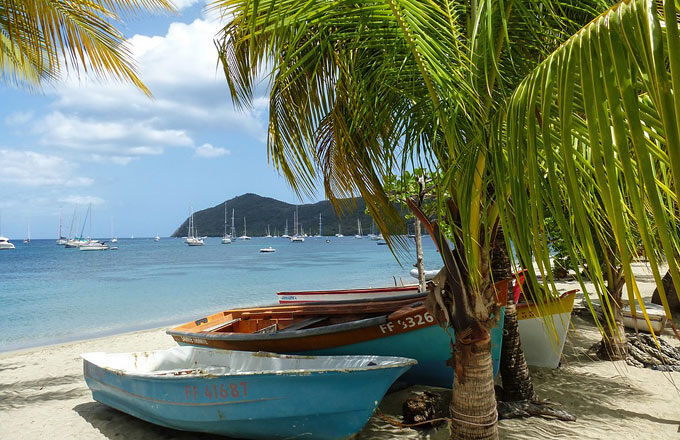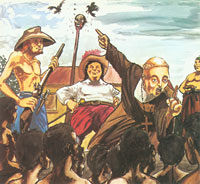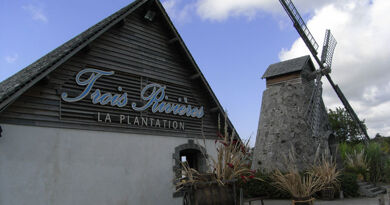Fishing in the West Indies, 300 years ago
1700. PERE LABAT Extract from his New Journey to the Isles of America. We have in the Isles only five or six ways of fishing: the seine, the line, the troll, the harpoon and the trap. I spoke of the last two in the first part of these Memoirs, speaking of the Turtles for fishing, of which the harpoon is used as well as for the Lamentin, the big Rays; and when we are on the high seas, for sea bream, albacore, blowers and other similar fish; we must now speak of the three other instruments that we use for fishing.
The seine is a large net of one hundred or sixty fathoms in length, and sometimes even more. It is given two to three fathoms in width in the middle. Everyone knows that a breaststroke is worth five feet of King. The meshes are quite wide at both ends, but they narrow as they approach the middle of the length where they are strongly pressed, and form a fairly deep pocket, from which it is difficult for the fish to come out . There is lead all along one side to make it go all the way, and cork or other light wood on the other to support it flush and keep it extended and plumb.
We put at each end of the seine a stick of good size as long as the seine is wide, at both ends of which we attach a rope loose enough to make an angle vis-à-vis the middle of the stick. We join to this angle a good rope of thirty to forty fathoms long, the end of which we leave on the ground while we go out to sea carrying the seine in a canoe, and throwing it into the water as we move away from the shore, making a large semicircle. Then bring to the ground the rope which is attached to the other end of the seine, and the people who are on the ground draw these ropes to them, and then the seine as nearly as they can, by approaching gently; and joining at the end together, while the canoe stands in the middle of the net, to prevent the caught fish from jumping over it, which still happens only too often.
This net sweeps, as it were, all the bottom of the sea, and collects all the fish which is there. Sometimes, although rarely, very large fish are caught, such as sharks, slippers, swordfish or other similar fish, which chase other fish, and finding a large number at the coast, are confined with them in the net; which is always only these large animals, which we do not care, cut and tear the seine, and flee with those they devoured and the others who were confined with them. When we realize that there is some fish of this species in a seine, we throw a hook as quickly as possible to stop it, or we try to harpoon it, or knock it out, and we pull the purse seine as cleanly as possible in order to make them fail, because one is sure to put them easily to reason when they have once the belly on the ground. Do not put the Swordfish among the fish that are not good to eat: it is excellent; we take a lot in the Mediterranean at the Fare of Messina. It is called Pesce Spada, or Fish with the sword (…). We see by this way of fishing that the seine can only be used to catch the fish that comes close enough to the coast, to be closed in the space that the seine can embrace, and that the one that is held offshore, and who does not bite the hook remains at rest. These fillets or seines must be made of good twisted hemp or pitte string; we must not fail to dye them with Rocou, or remnants of Indigo to give them a slightly dark color, because if they were white, they would appear too much in water, and would frighten the fish. The same precaution is used for the Fools, the Sparrowhawks and the lines that are used for fishing on the banks.
The second way to fish is at the bottom line. We choose the places of the sea whose depth has been recognized, which we consider as benches or flat and united lands at 30, 40, and up to 120 fathoms below the surface of the water. The fish in these places bite the hook; but as they rarely rise towards the middle region of the water, and it even less happens that they leave their homes, they must be fetched there with the line. It is usually good hemp or pitte string, well spun and well torso, from the size of a goose feather, to that of the little finger. The hooks or hains that are used must be proportional to the size of the line, and each to the strength of the fish that we know from experience to be on the banks where we are going to fish.
We hook the hook to a tail of archal wire, made up of seven or eight strands twisted together of the best, and the best cooked that we can find. Experience has shown that it is less likely to be cut by the teeth of a fish or broken in this way than if it were simple, albeit the same size of seven or eight strands together. This tail is given two and a half to three feet in length. We attach to the end of the line which joins the tail of archal wire a lead proportioned by its gravity to that of the whole line, so that it can pull it down. We still enter the same line at different distances five or six mediocre hooks to catch the fish that swim some distance above the bench. Fish are used to garnish the hooks; the one we use most often is the balaou or the sardine.
History of the Negro fisherman We had a Negro fisherman in our home, who was one of the most skilful and happiest who has ever practiced this profession. When he went out to go fishing, he asked the Religious what fish they wanted, and he brought them infallibly. This made him pass for witch among his comrades; others believed that he put a composition on the bait which attracted the fish and one claimed that it was human fat; I could not clarify this with him, because he was lost at sea some time before I arrived on the spot. But his son, who was almost as clever as him, assured me that what made his father so sure of bringing the fish he was asked for, was the long habit, and the perfect knowledge that he had schools , where experience had made him know the fish that were withdrawing there: for schooling fish rarely change their home, and mix little with those of a species other than their own. So that with this knowledge and dog fat, with which he rubbed the bait and the archal thread of his lines; it was very rare that he failed to catch the fish he wanted to have.




